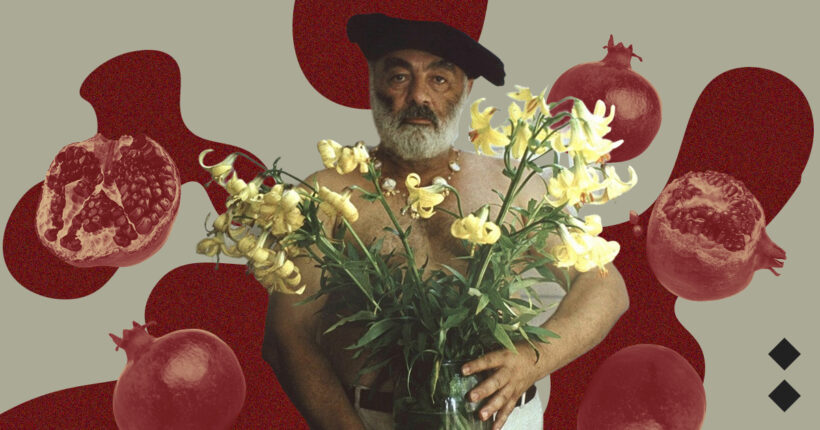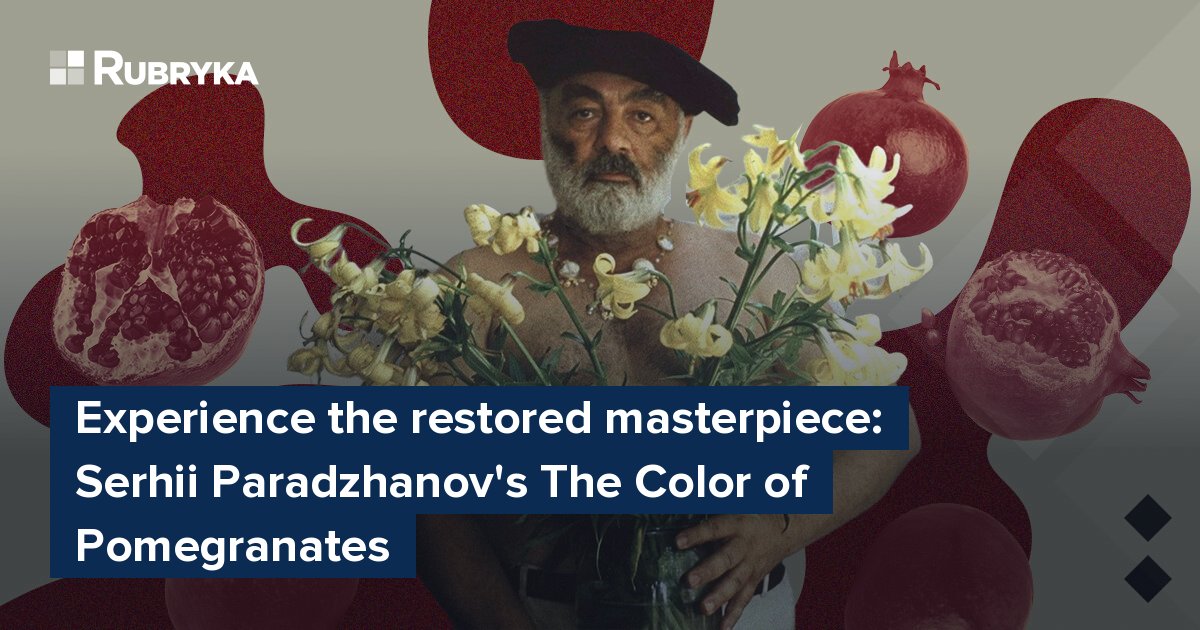
What's the problem?
Serhii Paradzhanov's most famous film, The Color of Pomegranates, was released twice in the Soviet Union in two versions — "censored" and "even more censored." Meanwhile, the rest of the world could only watch it through pirated copies since Soviet authorities banned the film's international distribution. None of these versions were the original cut.
The first screening of The Color of Pomegranates took place in Armenia in 1969. Some mistakenly believe this 77-minute version was the director's cut, but that's not true. It's more accurate to call it a compromise Paradzhanov had to make to get the film released.
The film was initially titled Sayat-Nova and was meant to tell the story of the Armenian ashugh Harutyun Sayatyan, better known by his pseudonym Sayat-Nova. Ashughs are traveling folk singers and poets who performed in villages and cities. However, Paradzhanov was forced to change the film's original title.
The Soviet authorities also made him remove all direct references to the poet. The officials at the State Cinema Committee were skeptical about Paradzhanov's innovative ideas. They didn't appreciate the film's use of metaphors, its allegorical style, or focus on Armenian culture.
"Alexei Romanov, the Chair of Goskino USSR (Moscow), personally disliked the film and refused to allow its distribution outside of Armenia," writes James Steffen, author of The Cinema of Sergei Parajanov, in his blog. "Paradzhanov was forced to remove all the direct references to the poet Sayat-Nova in the main title and intertitles on the grounds that he took too many poetic liberties with the historical figure."

Scenes from The Color of Pomegranates. Photo: Planeta Kino
After its Armenian premiere, the film sat on the shelf for four years until it was revisited by Soviet director Sergei Yutkevich. Yutkevich, a senior filmmaker and two-time Stalin Prize winner, had earned the trust of the State Cinema Committee.
Yutkevich admired Paradzhanov's work, especially the script, and decided to re-edit the film to get Romanov's approval for wider distribution across the Soviet Union. He cut several scenes, rearranged others, and added explanatory captions in Russian to make the film more accessible. In 1973, a 73-minute version was released, and though its screening was brief, it was shown across the Soviet Union.
Paradzhanov had no involvement in this re-edit. At the time, he was imprisoned in Soviet labor camps and sentenced to five years for homosexuality, though the charges also included "speculation" and "Ukrainian nationalism." In reality, Soviet authorities punished Paradzhanov for his support of the Ukrainian dissident movement.
The issue isn't just that we've lost the original director's cut and are left choosing between "less censored" and "more censored" versions. The Color of Pomegranates offers a unique visual experience, but the surviving versions were of poor quality and failed to capture the director's vision. You can see this difference in clips from the four preserved versions.
"Collectors will still want to acquire either the Kino or the Films sans Frontières disc since both contain the longer and somewhat less compromised Armenian release version, though both are seriously flawed image-wise," Steffen writes in his blog. "The Russian Cinema Council DVD of the Yutkevich cut looks better, but it's not on the level of their other Paradzhanov releases, which have been repackaged by various distributors worldwide."
What's the solution?
In 2014, Martin Scorsese's Film Foundation and Cineteca di Bologna restored The Color of Pomegranates. They revived the film's original colors and brought the editing as close as possible to Paradzhanov's original vision.
This restored version premiered at the Cannes Film Festival in 2014 and screened at several other festivals, including London, New York, and Toronto. Critic James Quandt described the film at the Toronto festival as "the cinematic Holy Grail."
When Martin Scorsese presented the restored version at the Toronto Film Festival, he told the audience they would witness images and visions "pretty much unlike anything in cinema history."


Scenes from The Color of Pomegranates. Photo: Planeta Kino
In honor of Serhii Paradzhanov's 100th anniversary, the restored version of The Color of Pomegranates will be shown in Ukrainian theaters for the first time. The film will be screened in 20 cities across Ukraine. The list of theaters showing the film can be found on the Arthouse Traffic website, the company responsible for bringing The Color of Pomegranates to Ukraine.
What's the film about?
The Color of Pomegranates tells the story of the 18th-century Armenian poet and ashugh, known by the pseudonym Sayat-Nova, which translates to "King of Song." The film is divided into eight chapters, each depicting a stage in the poet's life. However, Paradzhanov presents this story in an unconventional way.
Instead of a traditional narrative, Paradzhanov tells the poet's story through his poetry and inner world. We see him grow up, fall in love, enter a monastery, and eventually die. All these events are portrayed through symbolic imagery that reflects how Paradzhanov interpreted Sayat-Nova's poetry. The film has almost no dialogue and little camera movement, with most static shots. The visual imagery creates the film's energy, and Paradzhanov essentially invented his own cinematic language for this film.
"If someone sat down to watch The Color of Pomegranates with no background, they would have no idea what they were seeing. None at all," says critic Gregory J. Smalley. "Every carefully composed image in Pomegranates is coded to a meaning, but the key to interpreting them is missing. If you are a time-traveling Armenian from 1969, you will understand more of what is going on in Paradzhanov's vast visual poem than the average viewer — but not a lot more. Don't fight the movie. Just allow yourself to drown in the mystery of its images."
The film opens with a line from an Armenian poem: "I am the one whose life and soul are tormented." We then see the poet as a child in a village, surrounded by images that will follow him throughout his life — his lute, the iconographic texts of the Armenian Apostolic Church, and farm animals.
As the boy grows up, he marries but soon becomes a widower. He then becomes a priest but later leaves the clergy to wander and perform in villages and towns. Eventually, he is killed by the Persians.
"The Color of Pomegranates is essentially impressionistic and plotless, although the tableaux roughly follow the chronology of the life of Armenian poet Sayat Nova," Smalley explains.
Paradzhanov repeatedly expressed how much he loved this film during his life. This is further confirmed in the documentary The Color of the Armenian Land, filmed during the production of The Color of Pomegranates. In the documentary, Paradzhanov not only directs but also designs the costumes, sets, and overall visual style. Notably, he created the green dress worn by the angel at the end of the film.
"Paradzhanov dominated the set. He took on tasks that weren't even his," said Mikhail Vartanov, The Color of the Armenian Land director and a close friend of Paradzhanov. "He had to adjust and touch every single object on the set. Only he knew what was going on, but he never explained anything. Everyone just followed his instructions."

Serhii Paradzhanov designed the dress. Photo: The Criterion Collection
One fascinating detail about the film is that a single actor, the famous Georgian actress Sofiko Chiaureli, plays the leading roles. She portrays both Sayat-Nova, his beloved Princess Anna, and several other characters.

Sofiko Chiaureli as Sayat-Nova and Princess Anna. Photo: The Criterion Collection
Although The Color of Pomegranates remains an enigmatic film for many, it is still considered a masterpiece of world cinema. You don't have to understand everything happening in the movie—just come to the theater and try to immerse yourself in its beauty.
"Beyond the cinematic languages introduced by Griffith and Eisenstein, world cinema hasn't seen anything as revolutionary until The Color of Pomegranates by Paradzhanov," said Mikhail Vartanov.
Newsletter
Digest of the most interesting news: just about the main thing










